
Although COVID-19, commonly known as the coronavirus, is causing employers uncertainty for the future, they’re still hiring — even as many of their employees are working remotely. Federal law, however, requires employers to use the Form I-9, Employment Eligibility Verification to verify employment eligibility and to physically examine each original Section 2 document the employee presents “to determine if the document reasonably appears to be genuine and relates to the person presenting it” within three business days of the employee’s first day of work for pay, according to U.S. Citizenship and Immigration Services (USCIS).
In this time of social distancing, what should employers do?
To ease worries, the Department of Homeland Security (DHS) announced that it will defer the physical presence requirements for employers that have employees “taking physical proximity precautions due to COVID-19.”
Employers whose workforce is operating remotely may inspect the Section 2 identity and employment eligibility documentation remotely — via video link, fax or email, for example — within three business days of hire, and the employer must retain copies of these documents.
This provision only applies to employers and workplaces that are operating remotely — no exceptions will be made if employees are physically present at a work location.
Once normal business operations resume, employees whose documents underwent remote verification must report to their employer within three business days for official in-person document verification.
After employers physically inspect the documents, they should enter “COVID-19” in the Section 2 “Additional Information” field as the reason for the physical inspection delay. They also should state “documents physically examined” followed by the date of inspection in either Section 2 or section 3, as appropriate.
The DHS notes that employers may implement these provisions for a period of 60 days beginning March 20 or within three business days after this national emergency has ended, whichever comes first. Additionally, if employers qualify for and opt to use this provision, they “must provide written documentation of their remote onboarding and telework policy for each employee.”
Update: After several extensions throughout 2020 (on May 14, June 16, July 18, August 18, September 14, November 18, December 23) and 2021 (January 27, March 31, May 27, August 31, and December 20), the expiration date for these accommodations, as of May 1, 2022, is October 31, 2022.
For employees who initially undergo remote document verification, their subsequent Forms I-9 audits would be based on the “in-person completed date.”
Employers should continue to monitor the DHS and Immigration and Customs Enforcement (ICE) websites for additional updates on the ongoing national emergency.
As a reminder, at the end of January, the USCIS released a new Form I-9, version 10/21/2019 (found on the bottom of the form). Starting May 1, employers can only use the 10/21/19 version, which expires 10/31/2022. Make sure you’re using the most recently updated Form I-9; CalChamber provides the new Form I-9 for free on our website.
Jessica Mulholland, Managing Editor, CalChamber
Visit the CalChamber Coronavirus (COVID-19) webpage for more COVID-19-related federal, state and local resources, including CalChamber coverage.


